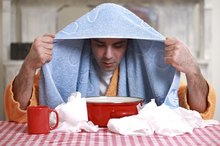What Are the Causes of Phlegm When Swimming?
Swimming is a good way to exercise and help you lose weight, strengthen your muscles and improve your overall health. However, you may experience an increase in phlegm inside your sinuses shortly after or during a swimming session. There are many different causes associated with the buildup of phlegm in your nasal passages, some of which are brought on by swimming or being submerged in water. Phlegm buildup can also be brought on by other medical conditions.
If you are experiencing serious medical symptoms, seek emergency treatment immediately.
Causes
While you are swimming, it is possible to have water naturally enter your nasal passages in a minor amount despite holding your breath when submerged. As such, your body naturally responds by producing phlegm inside your sinuses. This buildup of phlegm can cause you to hack or cough, even to the point of needing to spit. While this buildup is a natural bodily response, there are a few examples of other medical conditions that can cause phlegm production while swimming.
- While you are swimming, it is possible to have water naturally enter your nasal passages in a minor amount despite holding your breath when submerged.
- As such, your body naturally responds by producing phlegm inside your sinuses.
Asthmatic Bronchitis
Swimming With a Cough
Learn More
One example of such a medical condition is asthmatic bronchitis. Asthmatic bronchitis is associated with symptoms such as wheezing, coughing, shortness of breath, coughing up mucus or phlegm and an overall issue with breathing normally. Bronchitis is marked by an inflammation of the bronchial tube lining. This condition can be made worse by physical activity such as exercising or swimming and can cause you to become fatigued quickly due to lack of oxygen in your lungs. Treatment can include a prescribed inhaler.
- One example of such a medical condition is asthmatic bronchitis.
- Asthmatic bronchitis is associated with symptoms such as wheezing, coughing, shortness of breath, coughing up mucus or phlegm and an overall issue with breathing normally.
Swimming Induced Pulmenary Edema
Another possible condition that can cause a buildup of phlegm in your nasal passageways is swimming-induced pulmonary edema, or SIPE 2. According to Charles C. Miller, Jr., Ph.D., this condition can also cause a "flooding" of your lungs as they begin to fill with blood, phlegm or other liquids when submerged in deep water. Swimming can increase the severity of this condition due to a combination of factors "that creates what can be thought of as a 'perfect storm' that leads to capillary leak." When left untreated, this condition can cause additional medical disorders such as cardiac arrest or lung failure.
- Another possible condition that can cause a buildup of phlegm in your nasal passageways is swimming-induced pulmonary edema, or SIPE 2.
- According to Charles C. Miller, Jr., Ph.D., this condition can also cause a "flooding" of your lungs as they begin to fill with blood, phlegm or other liquids when submerged in deep water.
Considerations
The Effect of Breathing Exercises on Pleural Effusion
Learn More
If you begin to experience a shortness of breath during or immediately following swimming, be sure to take a rest for a few minutes to regain your composure. Coughing up a minor amount of phlegm is relatively normal due to your body's natural response to swimming. However, if you experience breathing difficulties for more than 30 minutes, seek medical attention as a means to rule out any additional severe complications.
Related Articles
References
- Penn Medicine: Chronic Bronchitis
- SlowTwitch.com; Swimming Induced Pulmonary Edema (SIPE); Katherine "Kat" Calder-Becker and Charles "Trey" C. Miller, III, Ph.D.; Sept. 2007
- Lillehoj EP, Kato K, Lu W, Kim KC. Cellular and molecular biology of airway mucins. Int Rev Cell Mol Biol. 2013;303:139-202. doi:10.1016/B978-0-12-407697-6.00004-0
- Bills G, Rose C. Principles of Pharmacology for Respiratory Care. Sudbury, MA: Jones & Bartlett Learning; 2019.
- Fahy JV, Dickey BF. Airway mucus function and dysfunction. N Engl J Med. 2010;363(23):2233-47. doi:10.1056/NEJMra0910061
- Seaton A, Leitch G, Seaton D. Crofton and Douglas's Respiratory Diseases. Hoboken, NJ: Wiley; 2008.
- Scaglione F, Petrini O. Mucoactive agents in the therapy of upper respiratory airways infections: fair to describe them just as mucoactive?. Clin Med Insights Ear Nose Throat. 2019;12:1179550618821930. doi:10.1177/1179550618821930
- American Thoracic Society. (2015). What Are the Signs and Symptoms of COPD?
- Centers for Disease Control and Prevention. (n.d.). Runny Nose (with green or yellow mucus).
- Martínez-girón R, Mosquera-martínez J, Martínez-torre S. Black-Pigmented Sputum. J Cytol. 2013;30(4):274-5.
- Nadel, J.A. (2016). Airway Epithelium and Mucous Secretion. Murray and Nadel's Textbook of Respiratory Medicine. 6th ed. 10, 157-167.
- National Health Service. (2015). Coughing up blood (blood in phlegm).
- Rogers, D.F. (2014). Airway Mucus and the Mucociliary System. Middleton's Allergy: Principles and Practice. 47, 739-753
- Rubin, B.K. (2002). Physiology of Airway Mucus Clearance. Respir Care. 47(7), 761-8
- Barnes, P.J., Drazen, J.M., Rennard, S.I. & Thomson, N.C. (2002). Asthma and COPD: Basic Mechanisms and Clinical Management. Academic Press : Elsevier
Writer Bio
Adam Fonseca has been a writer and blogger since 2005. He maintains a number of different blogs on a variety of subjects ranging from health care to golf. Fonseca has a Master of Health Administration degree from the University of Phoenix and degrees in health science and psychology from Bradley University.









